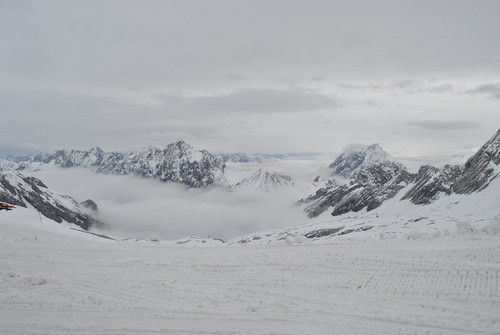On Tuesday, May 4, the fourth day of my travels, I took a train from Munich to Garmisch-Partenkirchen in southern Bavaria to connect with the Zugspitzbahn to ascend the highest mountain peak in Germany. The Zugspitzbahn is a cogwheel railway to climb the steep slope of the Zugspitze mountain. The station is adjacent to the Garmisch-Partenkirchen Bahnhof. The scenery was memorable on the way up, passing mountain homes, high pastures, and dramatic mountainsides. The train itself was modern, bright and comfortable.
The ride up takes about an hour, with the last portion through a tunnel, terminating at Zugspitzplatt, still 350m from the peak. From there a suspended cable car takes visitors the rest of the way to the top. I stopped at Zugspitzplatt to take in the view from there – which was the best view I had. It was very cloudy, but I could see some nearby peaks. It was spectacular – everything very bright and white with snow and fog. A minor hike up a hill from the rail/cable car station sits Maria Heimsuchung Church, the highest church in Germany.
I continued to the top, which took a bit of waiting as the cable car did not run very frequently. As we ascended fog quickly consumed everything in sight with nothing but bright whiteness until we reached the top. I immediately went to the top to the observation level and was the first one out there. It was incredible and bizarre. Visibility now was maybe 50-100 feet, so there was no view but whiteness. It was erie to look over the edge and see nothing. The unchanging bright whiteness began messing with my eyes. The temperature was probably below freezing – icicles and frost hanging off railings.
Half of the peak is actually in Austria, however the section was closed off. I knew the border was very near but did not realize it split the peak. So I never went to Austria, but I was very, very close. Nothing at the peak was really open (gift shop, etc.) so I took the cable car back down soon, and then had to wait a while for the next train.
After returning to town I spent an hour or so exploring on foot before the next train to Munich departed. Understandably, it reminded me of resort towns in the mountains of Colorado, but more legitimate. There were businesses, community and infrastructure not dominated by tourism alone. A characteristic of Garmisch-Partenkirchen were the numerous buildings decorated in ornate exterior frescos. Near the train station is the stadium from the 1936 Winter Olympic Games. Hitler had forced the two individual towns of Garmisch and Partenkirchen to merge in anticipation for the games. They remain unified today.
See all my photos from the Zugspitze and G-P here.
